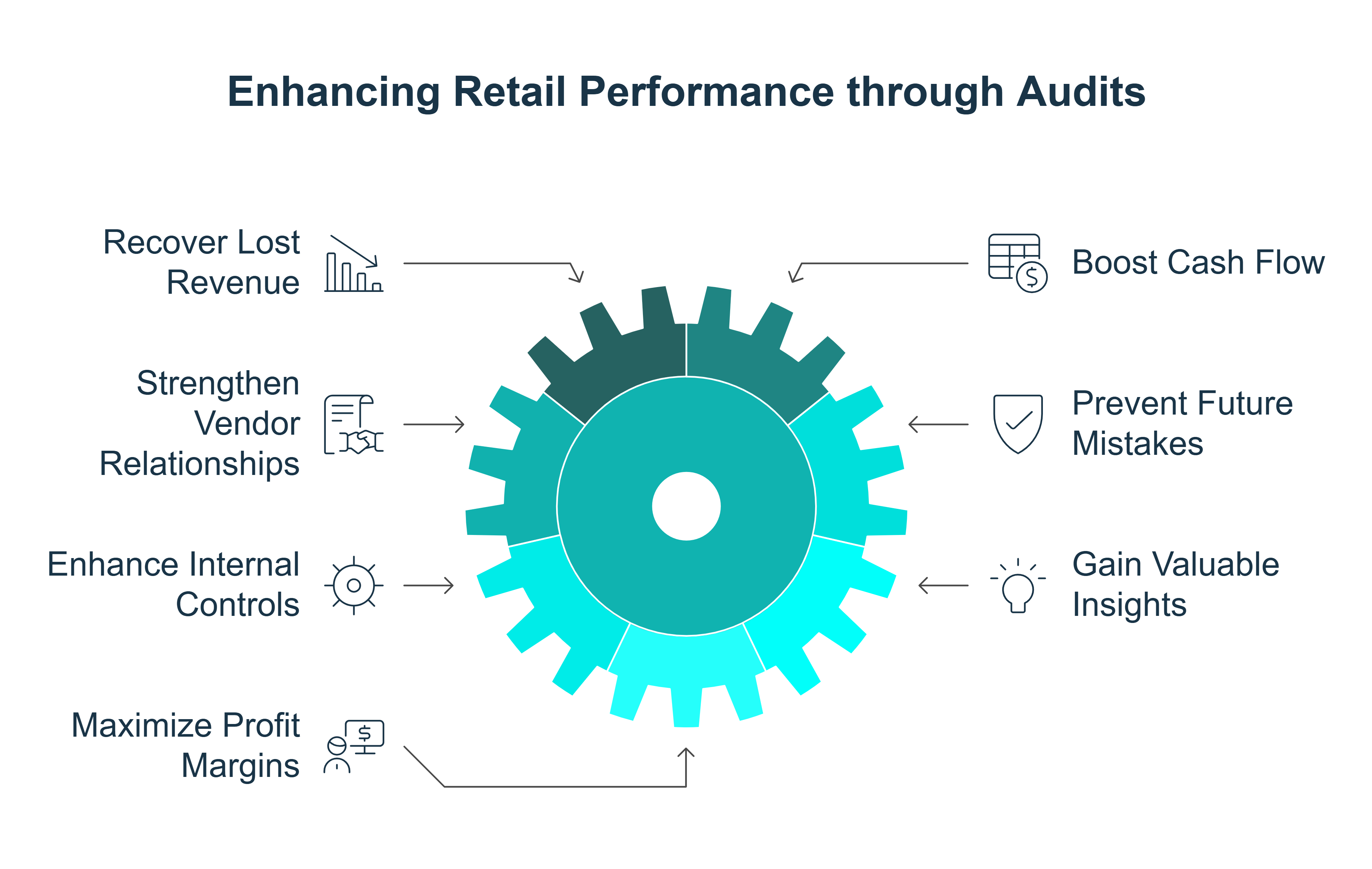Related Content
- How Accounting Leaders Evolve from Reactive Fixes to Proactive Prevention with Recovery Audits Powered by AI
- The Future CAO: How Artificial Intelligence is Redefining Accounting Leadership
- Where Should Accounting Leaders Focus Their Time and Efforts? Recovery Audits vs. Continuous Monitoring
- Mitigating the Loss of Profit in Retail: The Roles of Contract Compliance Audits and Artificial Intelligence in Preserving Profit Margins
- Driving EBITDA Growth Through AP Process Optimization and Revenue Recovery
- Preventing Overpayments: How AI-Driven Non-PO Invoice Management Supports AP Recovery Audits
- Uncovering the Most Frequent Leakage and Overpayment Scenarios in AP Recovery Audit
- Why CPG Giants are Turning to AP Recovery Audits to Fight Vendor Complexity and Price Discrepancies
- The Hidden Cost of Missed Credits in Retail AP: How Leading Brands Are Recovering Millions
- Manufacturing AP Recovery Audits: Mitigating Leakage from Freight, Tax, and Mosaic PO Structures
Running a retail business is like managing a constantly moving puzzle—thousands of vendors, millions of transactions, and countless details that can easily slip through the cracks. With so many variables, small errors in pricing, promotions, or agreements can quickly add up to big financial losses. That’s where retail merchandise recovery audits come in. These audits help retailers spot hidden leakages, recover lost revenue, and improve their bottom line. In this blog, we’ll dive into the benefits of retail merchandise recovery audits and why they’re crucial for running your retail operations smoothly and profitably.
What is a Retail Merchandise Recovery Audit?
A Retail Merchandise Recovery Audit identifies financial discrepancies hidden within your retail operations. It’s not just about finding mistakes—it’s about uncovering potential revenue opportunities. The audit involves reviewing vendor contracts, pricing agreements, invoices, and promotional activities, focusing on errors like overpayments, incorrect discounts, and missed allowances.
A recovery audit highlights these issues, helping businesses reclaim lost money while strengthening internal processes. This proactive approach makes it easier to spot and address problems before they escalate into larger, more costly issues.
Top 7 Benefits of Retail Merchandise Recovery Audits
From boosting cash flow to enhancing vendor relationships, retail merchandise recovery audits offer a wide range of benefits. Let’s dive into the top seven advantages of conducting a merchandise recovery audit and see how it can significantly improve your business performance.
1. Recover Lost Revenue
Small leakages can slip through the cracks in a busy retail environment—missed discounts, vendor overpayments, or unclaimed promotional funds. A recovery audit helps uncover these hidden financial losses, allowing businesses to reclaim funds they didn’t realize were slipping through the cracks.
Example: A large retailer working with hundreds of vendors missed out on promotional discounts worth over $1 million. They identified and recaptured these funds through a recovery audit, directly boosting their profit margins.
Pro Tip: Set up automated alerts in your ERP system for promotional discounts or payment due dates to prevent missed opportunities.
2. Boost Cash Flow
Retailers often have tight cash flow margins. By recovering lost revenue through an audit, businesses unlock capital that can be reinvested into operations, marketing, or inventory. This immediate influx of cash can make a big difference in daily operations.
Example: A national grocery chain recovered $500,000 from vendor overpayments. The recovered funds were used to restock fast-moving products, preventing supply chain disruptions.
Pro Tip: Schedule regular quarterly audits or mini-reviews to keep your cash flow optimized and identify potential issues early.
3. Strengthen Vendor Relationships
A thorough audit doesn’t just benefit the retailer; it also strengthens vendor relationships. By spotting discrepancies in contracts or pricing, retailers can engage in more transparent discussions, fostering long-term partnerships.
Example: A fashion retailer identified invoicing inconsistencies during an audit, which led to renegotiating more favorable contract terms that benefited both the retailer and the vendor.
Pro Tip: Regularly review vendor performance metrics and set up feedback loops, even before conducting an audit, to ensure smoother relationships and fewer discrepancies.
4. Prevent Future Mistakes
One of the greatest advantages of a recovery audit is uncovering the root causes of financial errors. Whether it's vague contract terms, invoicing mistakes, or promotional mismanagement, audits provide insights that help retailers prevent these errors from reoccurring.
Example: A retail chain frequently missed volume discounts due to unclear contract terms. After identifying the issue through an audit, they renegotiated contracts and implemented checks to ensure those discounts were always applied.
Pro Tip: Centralize your contract management system with a cloud-based solution to track terms and deadlines, reducing the risk of missed opportunities.
5. Enhance Internal Controls
Recovery audits don’t just find lost revenue; they also highlight weaknesses in a company’s internal controls. By addressing these weaknesses, businesses can improve efficiency and reduce the chances of future financial discrepancies.
Example: After an audit, a major electronics retailer implemented automated invoice matching to catch pricing errors early, significantly reducing manual reconciliation efforts and preventing future losses.
Pro Tip: Use AI and machine learning to improve internal auditing processes. These technologies can identify discrepancies more quickly and accurately than manual methods.
6. Gain Valuable Insights
Audits give retailers detailed insights into spending patterns, vendor performance, and contract management. These insights can guide better decision-making, leading to optimized operations and smarter vendor management.
Example: A global retailer discovered through an audit that certain vendors consistently charged more than the agreed-upon prices. With this knowledge, the retailer switched to more cost-effective suppliers, leading to long-term savings.
Pro Tip: Use audit data to create vendor performance scorecards, tracking their reliability, pricing accuracy, and overall value to your business.
7. Maximize Profit Margins
A merchandise recovery audit helps retailers maximize profit margins and create sustainable growth by recovering lost revenue, improving vendor relationships, and optimizing processes.
Example: A home goods retailer recovered $2 million from contract discrepancies, directly contributing to increased profit margins for the year.
Pro Tip: Conduct a cost-benefit analysis of audit findings. Prioritize high-impact areas where immediate changes can yield significant profit margin gains.

How to Get Started with Retail Merchandise Recovery Audit?
Ready to implement a Merchandise Recovery Audit but unsure where to start? Here’s a simple step-by-step guide to help you initiate the process and make the most out of it.
1. Understand Your Needs and Objectives
Before beginning, take the time to assess your current operations. Identify areas where you suspect errors or inefficiencies, such as vendor contracts, pricing agreements, or promotions. Setting clear goals will help you focus your audit efforts on the most impactful areas.
2. Choose the Right Partner
If you don’t have the internal resources or expertise to carry out a thorough audit, consider partnering with an experienced audit provider. Look for a partner who understands the complexities of your industry and has a proven track record of success in recovering lost revenue.
3. Conduct the Audit
Once you have your partner in place, the audit process begins. The audit team will review your vendor contracts, pricing terms, invoices, and promotional activities to identify any discrepancies. They will also review data to identify missed opportunities for savings.
4. Analyze the Results and Take Action
After the audit, you’ll receive a detailed report outlining the issues found, the amounts recovered, and areas for improvement. It’s crucial to act on the insights provided and implement changes to prevent future issues.
5. Implement Ongoing Monitoring
A one-time audit is valuable, but continuous monitoring ensures that your operations stay on track. By regularly reviewing vendor relationships and financial processes, you can prevent small errors from turning into bigger problems.
Conclusion
Retail merchandise recovery audits are more than just a way to uncover lost revenue—they are a strategic investment in your business’s financial health. By identifying discrepancies, enhancing internal controls, and optimizing vendor relationships, these audits lay the foundation for long-term success. When implemented effectively, the benefits of retail merchandise recovery audits can help retailers streamline operations, prevent costly mistakes, and boost profitability.
If you're looking to protect your profits and ensure smoother retail operations, starting a recovery audit is a crucial step toward building a more efficient and profitable future. Don’t wait—start now and drive sustained growth for your business!
Take the next step to recover your hidden savings. Request a Demo and see how AI powers smarter AP processes.
Frequently Asked Questions
If your business works with multiple vendors, manages numerous transactions, or has experienced issues with missed discounts or incorrect billing, a merchandise recovery audit can be highly beneficial. Even small operational inefficiencies or billing errors can lead to substantial revenue losses over time.
While small audits can sometimes be performed in-house, partnering with an experienced audit provider is often recommended. Professionals bring specialized knowledge, advanced tools, and an objective viewpoint to identify discrepancies that might otherwise go unnoticed. This ensures a thorough and efficient audit process.
Recovery audits can reveal a variety of errors, including overpayments to vendors, unclaimed promotional discounts, incorrect pricing, missed allowances, and errors in invoicing. Identifying these discrepancies helps recover lost funds and prevents future financial mismanagement.
The duration of a merchandise recovery audit varies depending on the size and complexity of your business. Generally, audits can take anywhere from a few weeks to several months. However, the process is designed to be thorough, ensuring that no potential recovery opportunity is overlooked.
By identifying and recovering lost revenue, a recovery audit can significantly boost your business’s profitability. The benefits extend beyond immediate financial recovery, helping you improve cash flow, strengthen vendor relationships, and prevent future errors—all of which contribute to long-term success.
Success can be tracked by evaluating the funds recovered, operational improvements made, and any long-term savings or efficiencies gained from the audit process. Additionally, comparing key performance indicators (KPIs) before and after the audit can highlight the improvements in vendor relationships, internal processes, and overall profitability.


.png)